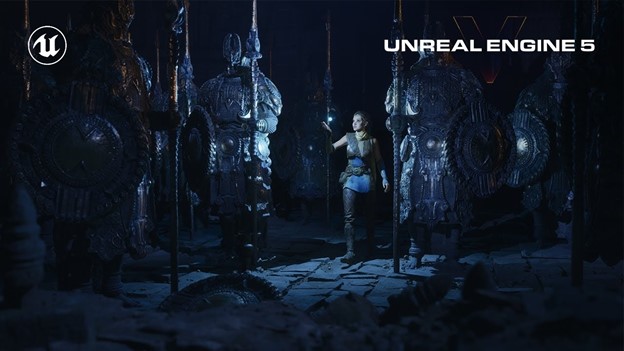The future of next-generation gaming: Unreal Engine V
Epic Games have been the leading developer in pushing the boundaries of visuals in video games using their in-house 3D creation tool: Unreal Engine. Unreal Engine is Epic Games’ advanced real-time 3D creation tool that captures photorealistic visuals and immersive experiences which was first showcased in the first-person shooter Unreal in 1998.
It’s been seven years since Epic Games launched Unreal Engine 4 for developers to use freely, but Epic Games has been working on the successor to Unreal Engine 4: Unreal Engine V.
As we close in on next-generation gaming and ninth-generation consoles adding new titles and IPs, developers are in for a treat with the capabilities Unreal Engine 5 can achieve.
Brian Karis, Technical Director of Graphics, and Jerome Platteaux, Special Projects Art Director, discussed the main goal for this engine being to achieve photorealism on par with film CGI and real life. It expands on Unreal Engine 4’s photorealistic visuals and technology making use of next-generation hardware to its advantage to produce smooth, visually appealing, photorealistic graphics.
On May 13th, 2020, Epic Games unveiled Unreal Engine V in a nine minute real-time tech demo presentation titled “Lumen in the Land of Nanite” which discussed the use of two new core technologies and how they’ll correspond to existing systems which could change the way developers render and utilize light.
Nanite is virtualized micropolygon geometry that allows artists to freely create as much geometric detail the eye can see. And by virtualizing geometry, this allows artists to get an infinite level of detailing from how far the camera is.
Lumen is a fully dynamic global illumination solution that immediately reacts to scene and light changes. This allows artists and designers to create dynamic scenes by controlling where light is casted.
The inspiration to use lumen could be from Luminous Productions who developed the Luminous Engine first showcased in the real-time tech demo “Final Fantasy: Agni’s Philosophy” in 2013. The demo uses Quixel Megascans to make the demo a cinematic experience with a million, 8K textured triangles using Virtual Text String. “Lumen in the Land of Nanite” uses over a billion triangles of geometry in each frame to which nanite can render large amounts of triangles incredibly quickly to the point where triangles are detailed down to pixels.
High poly assets were an important part of this demo as it allowed the engine to implement objects from ZBrush made with more than 33 million triangles. Epic Games confirmed that previous engine systems like Chaos physics, Niagara VFX, convolution reverb, and ambisonic rendering would be used again for Unreal Engine V.
On May 26th of this year, Epic Games gave us more information on other systems being implemented in Unreal Engine V in a 15 minute real-time tech demo presentation titled “Valley of The Ancients” which is a continuation of “Lumen in the Land of Nanite.”
One of the newest systems of Unreal Engine V is world partition which makes it easier for teams to collaboratively work on open world creations as it automatically divides the world into grids that stream the necessary cells required for work. Coinciding with the world partition system is the one file per system which makes it so that your team can work simultaneously on the same region of the world. The data layers system will also make it so that you can create different variations of your world.
A new tool coming to Unreal Engine V that allows artists to create characters with incredible detail is control rig: an artist friendly animation tool that’ll allow artists to create new rigs and share them with characters using sequencer and the full-body IK solver for natural, flowing movement. Motion warping is a new feature to Unreal Engine V that enables artists to dynamically adjust a character’s root animation to align with different targets.
Most recently, Epic Games collaborated with Warner Bros to create a new, cinematic tech demo for The Matrix Resurrections titled “The Matrix Awakens” which allowed players to experience iconic scenes from The Matrix created in Unreal Engine V as well as experiment with different features and settings in an open world environment.
Unreal Engine V is pushing the boundaries of visual technology in video games. Unreal Engine V isn’t just focused on one core aspect of visual technology, but allows artists to creatively construct open worlds and character movement through enhanced tool sets and features.
Gaming could start looking even more cinematic with photo realistic visuals and high resolutions, though frame rates may suffer. One of the bigger questions many have is how Unreal Engine V could be used outside of the video game industry? The possibility of Disney using Unreal Engine V for their LED stage and visual effects is likely considering Unreal Engine 4 was used for The Mandalorian.
Imagining the visual effect improvements and how possibly film and television shows could have high quality, photorealistic visuals is something that could also aid filmmakers in the future.
Though it is unclear when Unreal Engine V will be available for developers to start using, the future of next-generation gaming is looking bright. For more information and details on Unreal Engine V, visit the official website for Unreal Engine V or Epic Games.

Senior Savion Simmavong is a staff writer for the A-Blast. He's entering his first year with the staff. In his free time, he enjoys reading, playing video...








